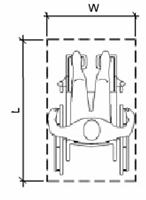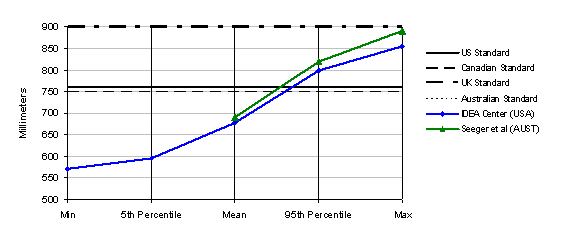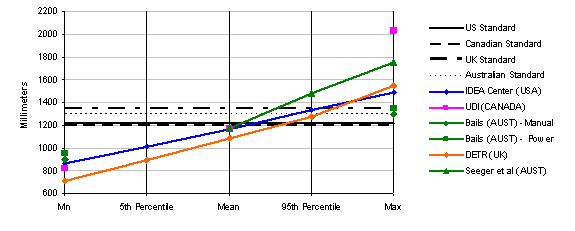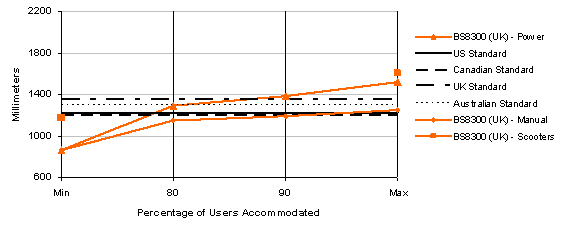4.2 Clear Floor Area
Figure 9 and Table 3 show the standards from the four countries related to clear floor area. Figures 10-13 show the key findings from the research.
Figure 9.
Table 3.
|
|
U.S. |
Australia |
Canada |
U.K. |
|
Width (W) |
760 |
800 |
750 |
900 |
|
Length (L) |
1200 |
1300 |
1200 |
1350 |
Figures 10-11. Clear Floor Area (Occupied) Width for All Devices
Figures 12-13. Clear Floor Area (Occupied) Length for All Devices
Recent revisions to standards in Australia and the U.K. have increased the clear floor area dimensions in both width and length. The U.K. requirements, in particular, are much larger requirements than those in the U.S. and Canada. Research results support larger dimensions. All the studies found that wheeled mobility devices vary from the standards significantly in both width and length. While there are many occupied devices that are narrower and shorter than the values in the standards, the largest devices are generally above the minimum width and length in the standards.
The findings on clear floor area are based on the findings on occupied width and length, where provided. The DETR study did not collect data on occupied width (see previous section). The authors argued that individuals can bring their arms and legs inboard when entering transportation vehicles and passing through doorways. We found, however, that many individuals cannot bring their body parts “inboard”.
The IDEA Center research results for occupied width were smaller than those of the Seeger study. No study reported widths larger than 850 mm. The BS8300 research did not report occupied widths larger than 800 mm but the BS8300 standard, as we interpret it, requires 100 mm more than that for the clear floor area width (900mm). The BS8300 standard’s developers may have added 100mm to provide additional maneuvering room at clear floor areas.
In all the studies that reported data by device type and percentile, the occupied widths of the smallest and largest power chairs were generally the same as the occupied widths of the manual chairs. Occupied widths of scooters were narrower with the exception of the IDEA Center findings. This can be attributed to the presence, in the IDEA scooter sub-sample, of some very large individuals and some who keep their legs outside the edge of the chair when in a resting position. Other studies may not have measured people in “resting” postures. The larger sizes of Americans may also contribute to this difference.
The largest occupied lengths all exceed the current standards, even the U.K. standard of 1350mm. However, the results show that the 95th percentile values are between 1200 and 1350 mm. The difference between the maximum length in the UDI and Seeger studies and the others is so great that it is probably due to the presence of unusually large people and/or devices or measurement error. The maximum length (occupied) recorded in the UDI study, for example, was over 2000 mm (over 6 ft.- 8 in.)! In the case of Seeger et al.’s work, we know that most of the sample was recruited from institutions and many may have had extended foot rests or reclined backs on their chairs. No information is provided in the reports to assess whether individuals in either study could be considered outliers. For example, the other studies together included over 1200 individuals and no other study reported a device as long as 2000 mm. Such a large value is likely to have been a measurement error or a very unusual case such as a person who uses a small all terrain vehicle for mobility.
The research results clearly suggest that clear floor areas be increased to address the actual size of contemporary occupied devices. Although there are differences in the findings, they can be attributed to methods and reporting approaches.
Recommendations
- The clear floor area width should be increased in the U.S. standards. A width of 800 mm (31.5 in.) would accommodate the 95th percentile in the IDEA sample
- The clear floor area length should be increased in the U.S. Standards. A length of 1400 mm (55 in.) would accommodate the 95th percentile in the IDEA sample






User Comments/Questions
Add Comment/Question